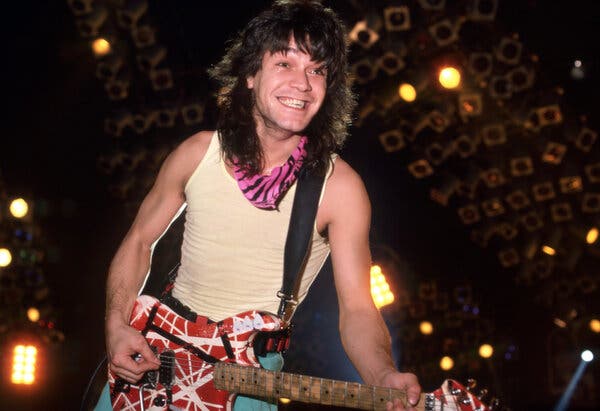Advertisement
An Appraisal
The guitarist, who died this week at 65, gleefully reinvented the rules of being a guitar hero — then bent them again and again.

Eddie Van Halen played not just fast but hyperfast. He played loud. He was flashy, assertive and explosive, often interrupting one virtuosic display with an even showier screech or run or glissando. As the lead guitarist in Van Halen, he plucked, tapped, strummed, bent, flicked, pinged and scraped his strings, simultaneously supporting his band’s lead singers and goading them with manic counterpoint.
And on the countless arena stages he played with Van Halen, as well as on camera for music videos, he did it all with an unforced smile — not the oh-so-melodramatic facial contortions of so many lead guitarists, but a grin of boyish delight at how he could blend propulsion, filigree and outright havoc, and at how much noisy fun he was getting away with. His signature red Frankenstrat guitar, decorated with black and white stripes, wasn’t a phallic weapon; it was an endlessly malleable toy.
Van Halen released its self-titled debut album in February 1978, introducing Eddie Van Halen as one of the last so-called “guitar heroes” who would connect with a mass audience. (Coincidentally, Prince, who could be a blazing guitar hero among his many other roles, released his debut album in April the same year.) It helped that Van Halen had pop hits. Although the band credited its songs to all of its members collectively, Eddie Van Halen took a major role in writing the music, from the annunciatory, pumping synthesizers of “Jump” to the grinding syncopated chords and hopscotching riff of “Unchained.” And then, often, he treated his own solid structures as playgrounds. He was architect and vandal at the same time.
Van Halen held his guitar-hero mantle while that role faced obsolescence. During Van Halen’s 1980s heyday, electronics and hip-hop were reshaping the pop mainstream, while much of hard rock went underground and splintered. Punk had already raised skepticism about fancy musicianship and guitar heroics, and when grunge pushed hard rock back onto the pop charts for a last gasp in the 1990s, guitarists dutifully subordinated themselves to their songs and their bands. The undeniable prowess of guitarists like Steve Vai, Joe Satriani, Yngwie Malmsteen or Buckethead would only make them heroes to a much more limited fan base.
Eddie Van Halen was an heir to guitarists and songwriters like Jimi Hendrix, Pete Townshend and Jimmy Page, whose command of their instruments fully merged traditional fretboard technique with an ever-expanding mastery of amplification and effects. But where those 1960s guitar heroes were thoroughly grounded in the vocalistic, storytelling tradition of the blues, Van Halen — both Eddie and the band — were one more step removed from the blues, grounded instead in Led Zeppelin and the Who themselves, in power chords and streaking solos.
Another non-blues influence was progressive rock, particularly the keyboard-like tapping technique of the English guitarist Allan Holdsworth, which Eddie Van Halen used in some of his swiftest, wildest solos. Van Halen, who would influence countless guitarists over the next decades, made himself the shredder supreme, flaunting precision, speed and sharp turns.
“Eruption,” the two-minute instrumental warm-up-turned-album-track that was the guitarist’s brash calling card on “Van Halen,” fused hard-rock impact — its opening power chord and dramatic final downward swoop — with the breakneck trills and methodical arpeggios of a classical étude, a long way from the blues. Throughout the Van Halen catalog — not to mention his racing, leaping, fibrillating solo on Michael Jackson’s “Beat It” — his guitar didn’t moan very often. Instead, it sprinted, jabbed, pole-vaulted, cackled and buzz-bombed. He could be melodic at times — like the moody bridge that suddenly arrives in the foot-stomping “Panama” — but he clearly preferred muscle and disruption.
Yet his disruption didn’t feel destructive. It was an overload of sheer exhilaration — at the agility of his fingers, at the ear-grabbing distortion he could summon and tweak, at the surprises he couldn’t resist springing all the way through a song. A joyful grin was at the core of his music, and it was well-earned.
